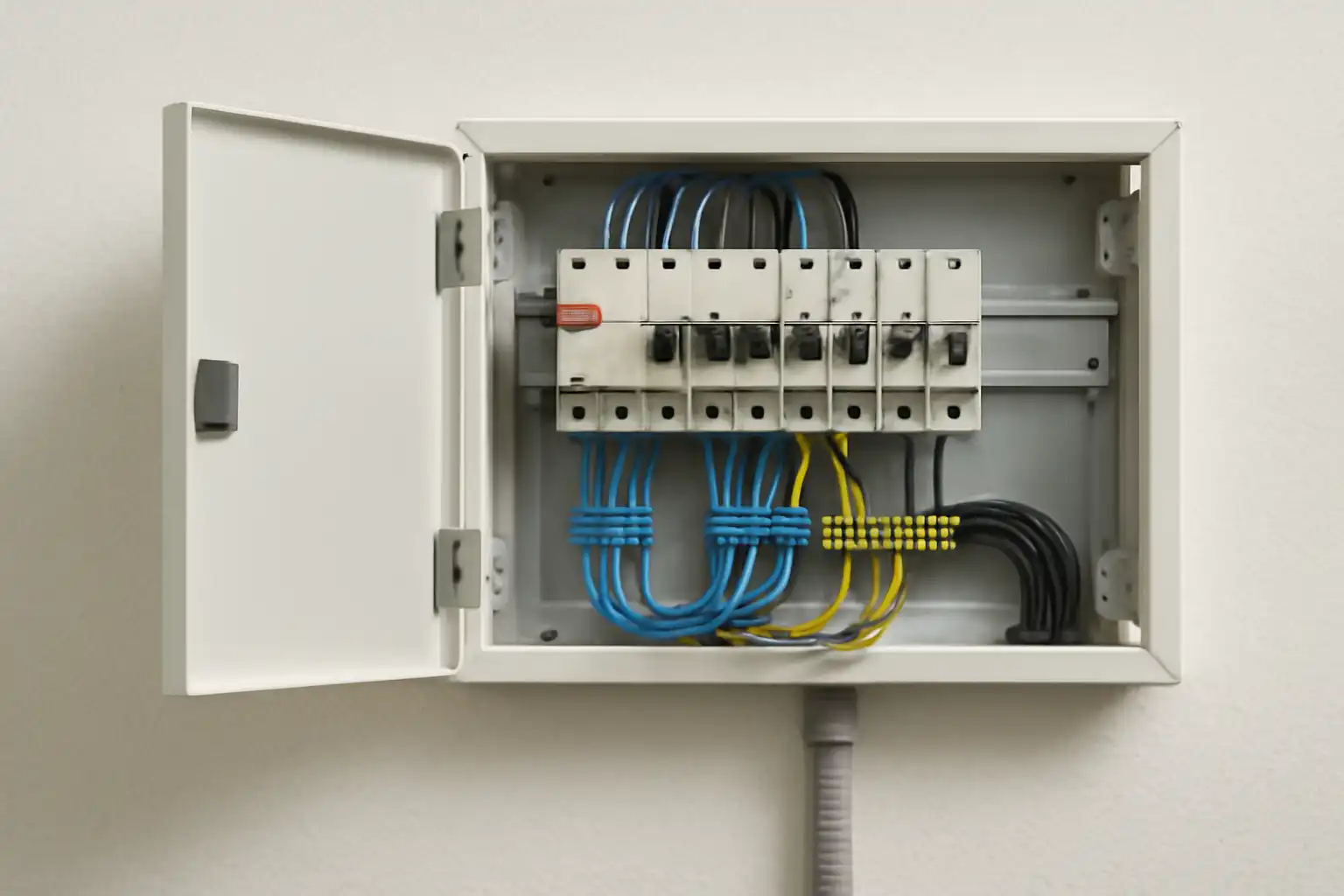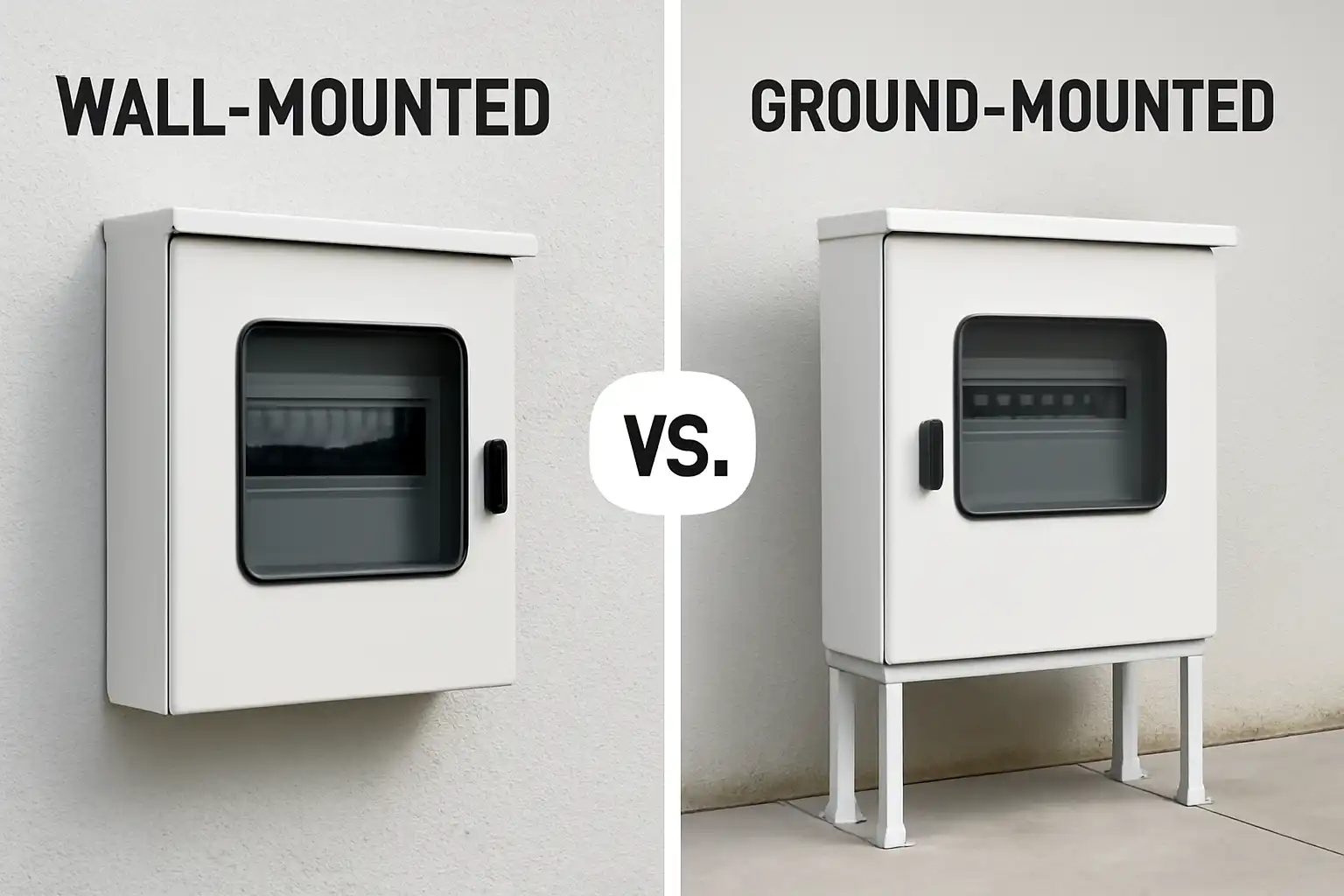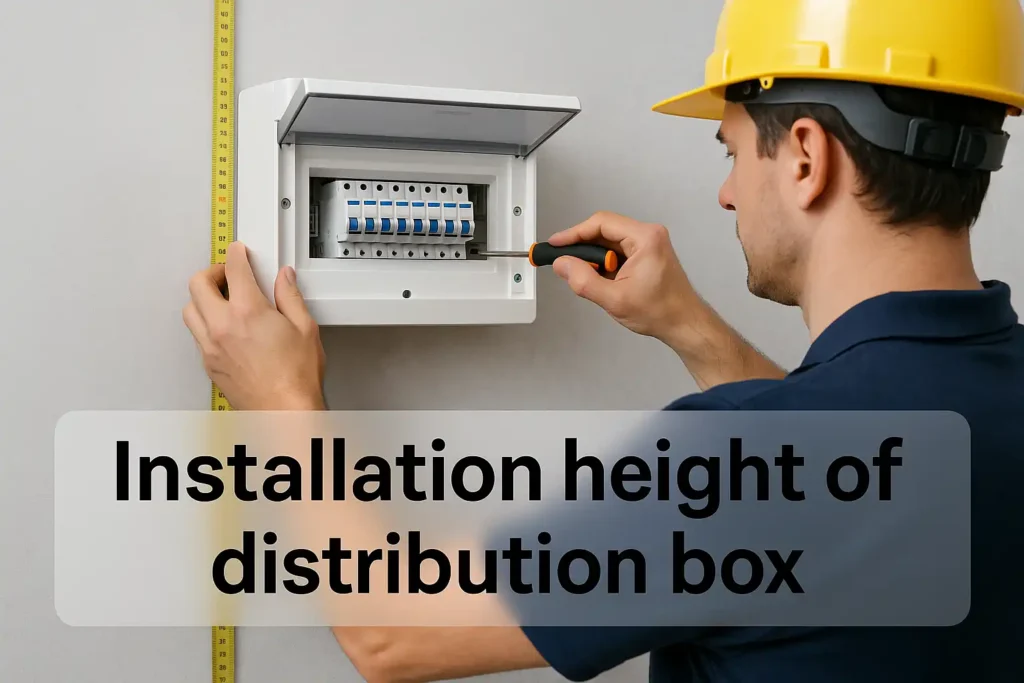The proper installation of a distribution box involves placing it at the right height to ensure safety and convenience. Mounting it 4.5 to 5.5 feet (1.4 to 1.7 meters) high makes it easily accessible without the need to bend or stretch excessively. This height also safeguards the box from potential water spills or accidental impacts. Adhering to these guidelines during the installation of a distribution box ensures both safety and compliance with standards.
Key Takeaways
-
Put wall-mounted boxes 4.5 to 5.5 feet high. This makes them easy to reach and safe to use.
-
Place outdoor boxes at least 3 feet above the ground. This keeps them safe from water and dirt.
-
Install boxes far from wet places to avoid damage. This helps keep them working safely.
-
Check and fix the box often to prevent problems. This ensures it works well and stays safe.
-
Get a licensed electrician to install the box correctly. This follows safety rules and avoids expensive errors.
General Guidelines for the Installation of Distribution Box
Standard Height Recommendations
Follow height rules when installing a distribution box. Wall-mounted boxes should be 4.5 to 5.5 feet high. This height makes it easy to reach without bending or stretching. Outdoor boxes need to be at least 3 feet above the ground. This keeps them safe from water and dirt. Ground-mounted boxes should be raised 2 to 4 inches to avoid moisture damage.
|
Type of Installation |
Recommended Height from Ground |
|---|---|
|
Outdoor Distribution Box |
Minimum 3 feet |
|
Ground-mounted (Foundation) |
2 to 4 inches above ground |
|
Wall-mounted (Flush) |
4.5 feet |
|
Wall-mounted (Surface) |
4 feet |
These heights follow rules like BS 7671 and IEC 60364-5-52. These standards make sure the box is easy to use and safe. For homes, the box height should be between 3 and 6 feet. A height of 4 feet works well for older or disabled people.
Key Factors to Consider
Think about several things when installing a distribution box. First, the height should let you read labels easily. This helps you check the system without straining. Second, keep the box away from water. Avoid wet places like sinks or uncovered outdoor areas. Third, the height should make repairs simple. You should open the box and reach parts without trouble. Lastly, safety matters. Place the box where it won’t get hit or damaged.
Tip: Pick a spot that’s easy to reach but safe from harm. This keeps your distribution box working well for a long time.
Importance of Accessibility and Safety
Making the distribution box easy to reach and safe is very important. An accessible box lets you check and fix it without much effort. For example, placing it at the right height makes it easy to use during emergencies. Safety means keeping the box away from risks. Install it far from water, fire hazards, or places where it might get damaged.
Following safety rules like BS 7671 ensures the box is installed correctly. These rules protect you and your home from electrical dangers. By focusing on safety and accessibility, you create a setup that is easy to use and secure.
Indoor Installation of Distribution Box

Residential Installation Tips
Install the box where it’s easy to reach. Good spots include hallways or utility rooms. Avoid wet places like bathrooms or kitchens. Moisture can harm the box. Mount the box 4.5 to 5.5 feet high. This height lets you reach it without bending or stretching.
Think about your home’s layout when choosing a spot. Keep the box away from furniture or appliances. These can block access. Label circuits inside the box clearly. This helps you find connections fast during repairs. If you have kids, use a lock or cover. This stops them from tampering with the box.
Commercial and Industrial Considerations
For businesses, follow local electrical rules when installing boxes. Place the box in a central spot. This shortens wiring and saves energy. Secure the box well to handle heavy electrical loads.
Industrial boxes need strong, fireproof covers. These protect against heat and chemicals. Install the box in bright areas for better visibility. Regular checks keep the system safe and working well.
Avoiding Common Indoor Hazards
Indoor risks can harm your box. Water is a big problem. Don’t put the box near sinks, washers, or pipes. Dust can build up inside and cause overheating. Clean around the box often to stop this.
Physical damage is another risk. Keep the box out of busy areas where it might get hit. Strange sounds or smells from the box mean trouble. Fix issues quickly. Good placement and care prevent these problems.
Outdoor Installation of Distribution Box
Weatherproofing and Moisture Protection
Protecting an outdoor distribution box from weather is very important. Rain, snow, or humidity can cause short circuits or fires. Always place the box in a dry spot, away from water like sprinklers or drains. Use a weatherproof cover to keep moisture out. These covers stop rust and keep the box working in tough weather.
Install the box about 5 feet (1.5 meters) high. This height makes it easy to reach and avoids water damage. In factories, you might need to place it higher to stay safe from machines or busy areas. Check the box often for damage caused by weather.
Outdoor Safety Standards
Outdoor boxes must follow strict safety rules to work well. For example, they need protection from moisture and rust, as stated in § 1926.432. Also, § 1926.431 says wiring in risky areas must stay free of dust and explosions. These rules help prevent accidents and keep your system safe.
Follow local rules when setting up the box. Make sure it’s grounded and mounted securely. Use lockable covers to stop people from tampering with it, especially in public places. Always hire a licensed electrician to meet these safety rules.
|
Section |
Description |
|---|---|
|
§ 1926.417 |
Requires tagging and locking out circuits during maintenance. |
|
§ 1926.431 |
Mandates dust and explosion prevention in hazardous locations. |
|
§ 1926.432 |
Specifies protection from moisture and corrosive agents for outdoor boxes. |
Ensuring Visibility and Accessibility
Make sure the box is easy to see and reach. Place it in a bright area so it’s easy to find, even in emergencies. Don’t hide it behind bushes, fences, or other things. Clear access makes repairs faster and safer.
The box should be about 5 feet high. This height lets adults reach it easily but keeps it out of small children’s reach. Label the circuits inside clearly to save time during repairs. By focusing on visibility and access, you make the box safer and easier to use.
Wall-Mounted vs. Ground-Mounted Distribution Boxes

Wall-Mounted Height Guidelines
Wall-mounted distribution boxes save space and are easy to use. Install them no higher than 6 feet 7 inches (2 meters). This height makes the box reachable but keeps it away from small kids.
You also need a clear area around the box. Leave at least 30 inches (762 mm) of width and 3 feet (914 mm) of depth. If the box is shorter than 6.5 feet, the workspace height should match the box’s height. These rules make repairs and maintenance easier and safer.
|
Requirement |
Specification |
|---|---|
|
Clearance |
At least 30 inches (762 mm) wide |
|
|
At least 3 ft (36 inches or 914 mm) deep |
|
|
At least 6.5 feet (≈ 2 meters) high |
|
Dedicated Space |
From floor to 1.8 m (6 ft) required |
|
Mounting Height |
Max 6 ft 7 in. (2 meters) above floor |
|
Workspace Height |
Same as box height if under 6.5 feet |
Following these rules keeps the box safe and easy to use.
Ground-Mounted Installation Tips
Ground-mounted distribution boxes work well outdoors or in factories. Raise the box 2 to 4 inches above the ground. This stops water and dirt from getting inside. Use a strong base to keep the box steady.
Put the box in a low-traffic area to avoid damage. Keep the space around it clear for easy repairs. Add weatherproof covers to protect it from rain, snow, and heat.
Tip: Check the box often for damage or wear. Fixing problems early saves money and keeps the system running well.
Pros and Cons of Each Type
Wall-mounted and ground-mounted distribution boxes have different benefits and downsides.
Wall-Mounted Boxes:
-
Pros: Save space, easy to reach, great for indoor use.
-
Cons: Need strong walls and may not last outdoors.
Ground-Mounted Boxes:
-
Pros: Good for outdoor use, resist water when raised, handle heavy tasks.
-
Cons: Take up floor space and need extra weather protection.
Pick the type that fits your needs and the location best.
Compliance with Safety and Regulatory Standards
Overview of Electrical Codes
Electrical codes are rules to keep distribution boxes safe and working well. These rules explain how to install, maintain, and use them properly. Following these codes protects you from electrical dangers and keeps the system running smoothly. For example, plumbing systems stop dirty water from mixing with clean water. Similarly, electrical systems need proper grounding and insulation to avoid problems.
Make sure the materials used for the distribution box meet approved standards. This ensures they are strong and safe. The rules also require enough space around the box for easy repairs. By following these guidelines, you make the area safer for everyone.
Tip: Check your local electrical rules before starting any project. This helps you avoid mistakes and follow the law.
Role of Professional Installation
Hiring an expert to install a distribution box is a smart choice. Electricians know how to handle complex systems and follow safety rules. A proper setup reduces risks and makes the system last longer. It also helps the box work better, saving energy.
Professionals use certified tools and materials, which adds extra safety. They test the system after installing it to ensure everything works. Without training, it’s hard to match their skill. By hiring a pro, you save time and avoid dangers.
Note: A badly installed box can cause big problems, like fires. Always hire a licensed electrician for this important job.
Avoiding Common Installation Errors
Mistakes during setup can make your distribution box unsafe or unreliable. One mistake is placing the box in wet areas. This can cause short circuits and damage. Another error is not having good drainage in flood-prone spots. Proper drainage keeps water away from the box.
Using cheap materials is another problem. Always pick approved materials made for electrical use. Wrong wiring is also a common issue. It can make the system fail or stop working. To avoid these problems, follow safety rules and hire experts when needed.
Reminder: Regular checks help find and fix problems early. This keeps your system safe and running well.
Placing a distribution box at the correct height is important. Think about where it will be, indoors or outdoors. Also, decide if it will be on a wall or the ground. Following safety rules and asking experts for help ensures it’s done right. Good placement lowers dangers and makes fixing it easier. By focusing on easy access and safety rules, the system will work well and last longer.
FAQ
What is the standard height for a wall-mounted distribution box?
A wall-mounted distribution box should be 4.5 to 5.5 feet high. This height makes it easy for adults to reach but keeps it out of small children’s reach.
What factors should you consider when choosing the installation height?
Think about ease of use, safety, and the environment. The box should be simple to reach, far from dangers like water or fire, and placed for easy repairs. Always follow local electrical rules.
Tip: Make sure the height works for everyone, including people with mobility issues.
What happens if the distribution box is installed too low?
If the box is too low, it might get wet, collect dirt, or be touched accidentally. It can also be harder to use during emergencies or repairs.
What tools do you need to measure the correct height?
You’ll need a tape measure, a level, and a pencil or marker. These tools help you mark the right height and keep the box straight on the wall.
What are the risks of not following height regulations?
Not following height rules can cause safety problems like shocks or fires. It might also break local laws, leading to fines or needing to reinstall the box.
Reminder: Always hire a licensed electrician to install the box correctly.
The following information may be of interest to you
6 key points on how to choose a distribution box
What is the Function of a Distribution Box in Electrical Systems
Can surge protectors be installed outdoors



